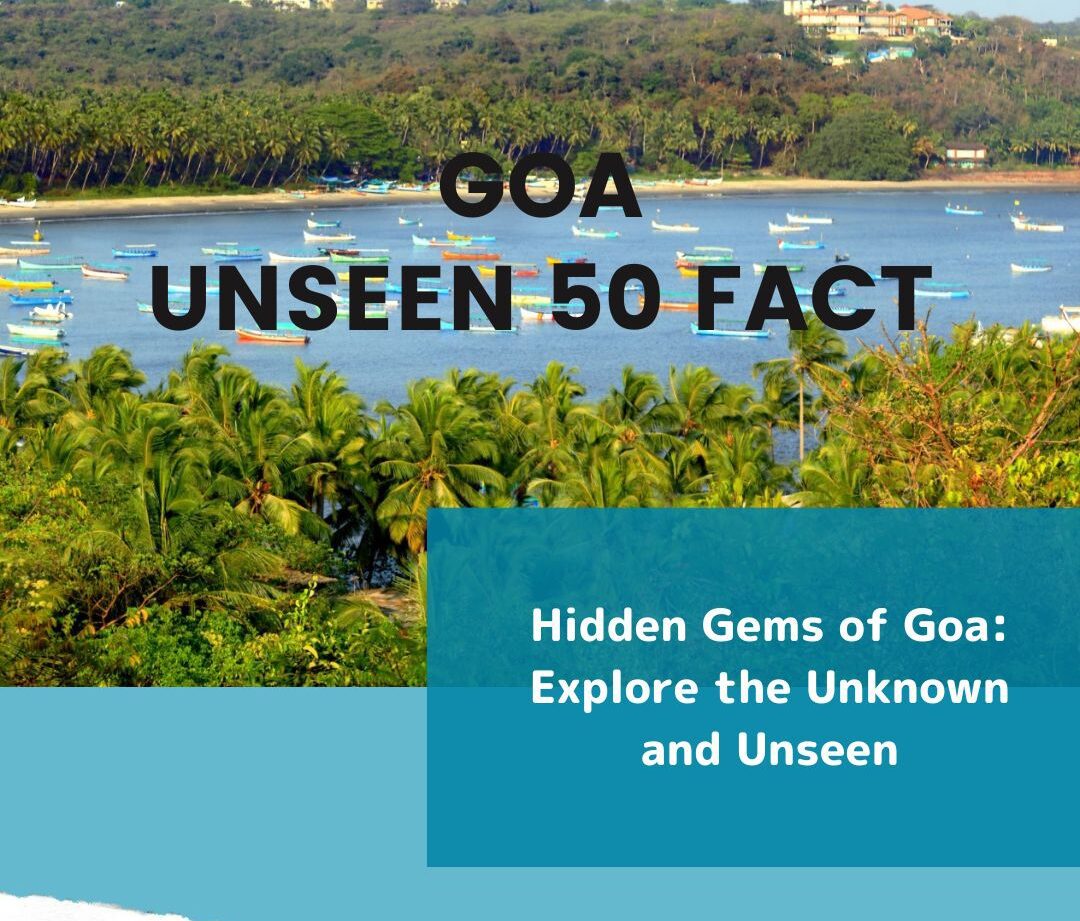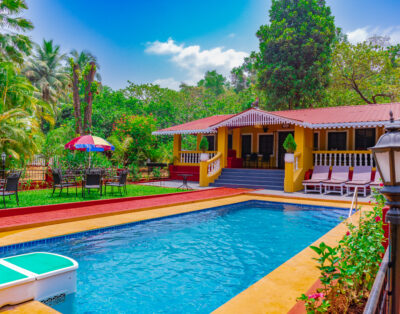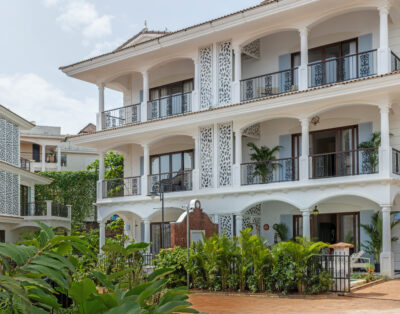Hidden Gems of Goa: Explore the Unknown and Unseen

Here are some exciting and lesser-known facts about Goa:
- Unique Architecture: Goa is home to the only Latin Quarter in India, located in Fontain has, Panjim. The vibrant, colorful houses with Portuguese influence make it a charming and historic neighborhood.
2. Biodiversity Hotspot: Goa has two UNESCO-recognized biodiversity hotspots: the Western Ghats and the Salim Ali Bird Sanctuary. The state is a paradise for nature lovers, with over 400 bird species and rich flora and fauna.
3. Oldest Church in India: The Basilica of Bom Jesus in Goa, built in 1605, is one of the oldest churches in India and is a UNESCO World Heritage site. It holds the remains of St. Francis Xavier, a revered Catholic saint.
4. First Printing Press in Asia: Goa was home to Asia’s first printing press, established by the Portuguese in 1556. It played a crucial role in the spread of literature and knowledge in the region.
5. Spice Plantations: While Goa is famous for its beaches, it also boasts lush spice plantations where you can explore and learn about the cultivation of spices like pepper, cinnamon, and nutmeg.
6. Rich History of Shipbuilding: Goa has a long history of shipbuilding dating back to the 16th century. The ships built here were used by the Portuguese to explore and trade across the globe.
7. Largest Man-Made Lake: Goa is home to Mayem Lake, the largest man-made lake in the state. It is a popular spot for picnics and boating amidst scenic surroundings.
8. Grape Stomping Tradition: Although Goa is more famous for feni, it also has a thriving wine culture. Many vineyards offer grape stomping events, a fun and traditional way to make wine.
9. Silent Noise Parties: Goa is known for its unique “Silent Noise” parties where party-goers wear wireless headphones and dance to music in near silence, avoiding noise pollution and complaints from locals.

10. Rich Marine Life: Goa’s coastal waters are home to vibrant marine life, including the elusive Indo-Pacific humpback dolphin. Dolphin-watching tours are a popular activity among tourists.
11. Oldest Floating Casino: Goa is home to the first floating casino in India, the “Casino Goa,” which was launched in 1999. This offshore casino culture is a unique aspect of Goa’s tourism.
12. Portuguese Influence on Cuisine: Goa’s cuisine is heavily influenced by its Portuguese heritage, with dishes like vindaloo, bebinca, and xacuti being popular local favorites that blend Indian and European flavors.
13. Secret Underground Tunnels: Some of Goa’s old Portuguese-era churches and forts are rumored to have secret underground tunnels, which were used during wartime for escape and supplies.
14. Largest Church Bell in Goa: The Se Cathedral in Old Goa houses the largest church bell in the state, known as the “Golden Bell.” It is famed for its rich tone and is one of the largest in Asia.
15. Home to India’s First Medical School: Goa Medical College, established in 1842, is the oldest medical college in Asia and was originally set up by the Portuguese to train locals in Western medicine.
16. UNESCO World Heritage Site – Sacred Groves: Apart from its churches, Goa also has sacred groves known as “devrai,” protected forests revered by local communities for their spiritual significance.
17.Mysterious Magnetic Hill: Goa has its own version of a magnetic hill near the town of Verna, where vehicles appear to roll uphill against gravity, creating a fascinating optical illusion.
18. Rich Carnival Tradition: Goa’s carnival, celebrated before Lent, is a vibrant and colorful festival that reflects its Portuguese legacy. It is marked by parades, dances, music, and elaborate costumes.
19. Secret Beach Hideaways: While Goa’s popular beaches are known to many, there are still some hidden gems like Butterfly Beach, which are more secluded and less crowded, offering tranquil experiences.
20. Vibrant Art and Craft Culture: Goa is known for its unique art forms, including the ancient craft of Azulejos (Portuguese ceramic tiles) and traditional Kunbi sarees, a craft revived in recent times.
21. Unique Local Liquors: Beyond the famous feni, Goa also produces urak, a lighter version of feni, and caju toddy, made from cashew apple sap, showcasing the region’s unique local beverages.
22. Home to an Endangered Language: The Konkani language, spoken in Goa, is one of India’s oldest languages and is listed as a vulnerable language by UNESCO due to the decline in the number of speakers.
23. Ancient Temples: Goa’s temples like the Tambdi Surla Mahadev Temple, dating back to the 12th century, showcase intricate architecture and are some of the few that survived the Portuguese era.
24. Mystical Dudhsagar Falls: The Dudhsagar Falls, one of India’s tallest waterfalls, is located on the Goa-Karnataka border. The name means “sea of milk” due to the waterfall’s frothy appearance.

25. Rich Tradition of Handicrafts: Goa’s artisans are known for their expertise in crafting items from coconut shells, bamboo, and clay, which are sold in vibrant markets like Anjuna and Mapusa.
26. The Hidden Caves of Goa: Apart from its beaches and churches, Goa also boasts ancient caves like the Arvalem Caves, dating back to the 6th century, which are believed to have Buddhist origins.
27. The Mysterious Lady of Velsao: Velsao Beach is not just known for its beauty, but also for the legend of a mysterious lady who is said to appear during full moon nights, adding an eerie charm to the location.
28. Goa’s Only Naval Aviation Museum: The Naval Aviation Museum in Vasco da Gama is the only one of its kind in Asia, showcasing the history of naval aviation with exhibits of aircraft, weapons, and more.
29. Spice Plantations: Goa’s spice plantations, like those in Ponda, are a hidden gem where visitors can explore the cultivation of exotic spices like cardamom, cinnamon, and black pepper, experiencing a different side of Goan agriculture.
30. The Sao Joao Festival: Unique to Goa, the Sao Joao festival is celebrated in June, where people jump into wells and streams to mimic St. John the Baptist’s act of baptizing Jesus, making it one of the most colorful and wet celebrations.
31. Ancient Coins Found in Goa: Archaeological discoveries in Goa have unearthed coins from ancient civilizations, including Roman and Kadamba dynasties, suggesting Goa’s historical importance in trade routes.
32. Goa’s Own Wine: Besides the local liquor feni, Goa also produces its own unique wine, made from local grapes, which is lesser-known but beloved by those who discover it.
33. The Legend of the Dona Paula: Dona Paula is one of Goa’s most famous spots, known for the legend of Dona Paula de Menezes, who is said to have leapt to her death from the cliff here due to a tragic love story. This spot is now a popular tourist destination.
34. Underground Gambling Culture: While Goa is known for its legal casinos, there’s also an underground gambling culture that has existed for centuries, tied to traditional games and festivities.
35. The Village of Korgao and its Witch-Hunting Rituals: Korgao village in Goa has an eerie past, where people once believed in witch-hunting rituals. These practices have long since ceased, but the stories linger.
36. Traditional Fishing Techniques: Goa’s fishing communities still use ancient techniques like ramponn, a type of shore seine net, that have been passed down through generations, offering a glimpse into the traditional way of life.
37. Home to India’s Only Palace on Water: The Mayem Lake, located near Bicholim, hosts a unique structure often referred to as Goa’s “floating palace,” a building on stilts in the middle of the lake, used for tourism purposes.
38. Unique Feast of Three Kings: The Feast of the Three Kings is celebrated at the Chapel of Our Lady of Remedios in Goa, where three boys from nearby villages are selected to represent the Magi and are given special status for the day.
39. The Disappearing Lake of Carambolim: Carambolim Lake is not just a birdwatcher’s paradise but also a seasonal lake that tends to dry up completely during certain months, adding a mysterious element to its beauty.
40. The Sacred Salt Pans of Goa: The traditional salt pans in Goa, particularly in the Ribandar area, are not just for salt production but are also considered sacred, with rituals performed during the salt harvesting season.
41. Goa’s Rare Mango Varieties: Beyond the popular Alphonso, Goa is home to rare mango varieties like the Mankurad and Hilario, which are a delicacy and highly sought after in the local markets.
42. The Bonderam Festival of Divar Island: Celebrated on the Divar Island, Bonderam is a lesser-known festival that mocks the old Portuguese practice of resolving disputes by placing flags. The festival involves a colorful parade, mock fights, and music.
43. Portuguese-Era Handloom Weaving: The traditional weaving of Kunbi sarees by the Goan tribals, influenced by Portuguese styles, is a craft that was nearly lost but has recently been revived.
44. The Mysterious Forest of Betul: Betul is home to a mysterious forest area that locals believe is haunted by spirits. This forest, with its dense vegetation and eerie silence, has been the subject of many local legends.
45. Renaissance-Era Churches: Goa is home to many churches that date back to the Renaissance, featuring architectural styles that are rare in other parts of India, showcasing the blend of Indian and European influences.
46. The Sacred Banyan Tree of Borim: In Borim village, there is a centuries-old banyan tree considered sacred by locals. It is believed to be the dwelling place of spirits, and offerings are made to appease them.

47. The Magnetic Hill of Verna: Like the famous Magnetic Hill in Ladakh, Goa has its own magnetic hill near Verna. It’s an optical illusion where vehicles appear to roll uphill when parked on a certain stretch of road.
48. The Abandoned City of Chandor: Chandor was once the capital of ancient Goa under the Bhoja dynasty. Now a quiet village, it’s home to relics of a bygone era, including ancient carvings and ruins.
49. Traditional Coconut Toddy Tapping: Goa is known for its local drink, feni, but fewer people know about toddy tapping, where sap is collected from coconut trees early in the morning and fermented to make a mild alcoholic beverage.
50. The Hidden Temples of Rivona Caves: The Rivona Caves, believed to be a Buddhist meditation site, are home to ancient rock-cut temples and carvings, offering a glimpse into Goa’s early religious history.
Discover the lesser-known wonders of Goa beyond the beaches and nightlife. From hidden waterfalls and ancient forts to unique cultural traditions, Goa offers an abundance of experiences waiting to be explored. After a day of adventure, unwind in the comfort and luxury of our villas. Whether you’re seeking relaxation or more exploration, our villas provide the perfect home base for your Goan getaway. Book your stay with us and make your trip to Goa unforgettable!





